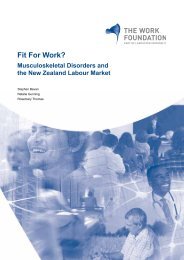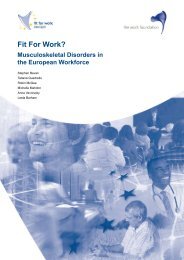FfW Bulgarian report (English language) - Fit for Work Europe
FfW Bulgarian report (English language) - Fit for Work Europe
FfW Bulgarian report (English language) - Fit for Work Europe
You also want an ePaper? Increase the reach of your titles
YUMPU automatically turns print PDFs into web optimized ePapers that Google loves.
4.4<br />
The<br />
biopsychosocial<br />
model and work<br />
Interventions<br />
52<br />
area where more support could be provided is psychological support. As noted previously,<br />
the psychological effects of RA can be an important factor in managing the impact of disease,<br />
including the belief that people can recover, however, it seems that there is currently no<br />
government support available <strong>for</strong> psychological interventions <strong>for</strong> those with chronic conditions<br />
and patient groups are limited as to what they can fund. 41<br />
Prompt referral to specialists <strong>for</strong> confirmation of diagnosis and the start of treatment is also<br />
essential <strong>for</strong> those with AS and other rheumatic conditions, however, due to difficulty with<br />
diagnosis this does not seem to be happening in Bulgaria. 42 4.3.3 Spondyloarthropathies<br />
Since (similarly to RA) there is<br />
no cure <strong>for</strong> AS, the aim of therapeutic intervention is to reduce inflammation, control pain<br />
and stiffness, alleviate systemic symptoms such as fatigue, and to slow or stop the long-term<br />
progression of the disease. The prescription of non-steroidal anti-inflammatory (NSAIDS) or<br />
anti-TNF drugs coupled with regular physiotherapy <strong>for</strong>ms the current basis <strong>for</strong> the treatment of<br />
AS.<br />
As AS typically affects relatively young people, its potential to disrupt or even curtail an<br />
individual’s labour market participation may be significant. As we have discussed, there are<br />
important clinical, social and economic benefits to keeping these patients in work as long<br />
and consistently as possible. Depending on the severity of their condition, AS patients can<br />
benefit from workplace adjustments, flexible working arrangements, exercise regimes and<br />
physiotherapy (Boonen et al., 2001).<br />
The biopsychosocial model advocates that clinicians, occupational health professionals and<br />
others should assess the interplay between the biological (eg disease, joint damage), the<br />
psychological (eg disposition, anxiety) and the social (eg work demands, family support).<br />
Clearly, the psychological disposition and behaviour of a patient can have a significant impact<br />
on the way a physical ‘injury’ (such as back pain) is approached by a patient. In some cases<br />
the patient risks entering a self-rein<strong>for</strong>cing cycle of incapacity, delayed recovery and even<br />
depression if their dominant response to pain is to ‘catastrophise’ it. Of course there may be<br />
many factors which affect an individual’s disposition to ‘catastrophise’, including personality,<br />
previous medical history, levels of family support or job satisfaction (Sullivan and D’Eon,<br />
1990). It is evident that the interaction of the biological, psychological and social dimensions<br />
can have a significant impact on the development, progression of, and rehabilitation from, a<br />
musculoskeletal condition.<br />
41 Expert interview<br />
42 Expert interview<br />
<strong>Fit</strong> For <strong>Work</strong>?







